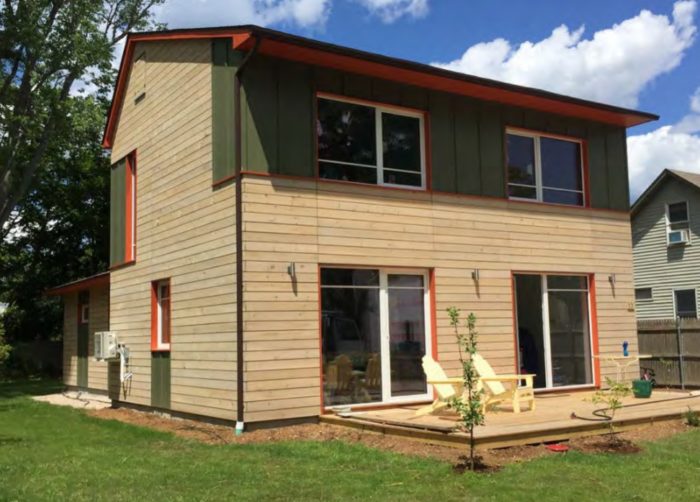
Image Credit: All images: Stephen DeMetrick
A family in Wakefield, Rhode Island, recently moved into a new 1,840-square-foot Passive House with three bedrooms and two bathrooms. If you exclude the cost of the lot, the architectural fees, and the cost of getting the house certified by PHIUS, the construction cost was $300,420, or $163 per square foot (if you measure the area of the house on the exterior).
The members of the team that built the house include Brad and Jordan Hevenor, the homeowners; Steve Baczek, the architect; and Stephen DeMetrick, the builder.
At this year’s NESEA conference (BuildingEnergy 18) in Boston, Demetrick gave a presentation describing the details and methods used to build the Hevenors’ house.
In search of builder-friendly details
DeMetrick is a certified Passive House contractor from Wakefield, Rhode Island. He told the audience in Boston that his goal is to make homes that meet the Passive House standard “replicable.” He wants these homes to be seen as “normal houses for normal people.”
The project goals for the Hevenors’ house was to come up with simple construction details that were builder-friendly, using everyday materials and methods. The team was trying to stick to a construction budget of $282,000. They came close to hitting that number, but ended up with a budget overrun of $18,000. About $10,000 of that number came from owner changes.
Nothing exotic
The foundation consisted of a standard perimeter frost wall surrounding a slab on grade. DeMetrick said that he deliberately chose a foundation type that is familiar to most concrete contractors. “I didn’t want people working on the project to have to know what we are doing,” said DeMetrick. “My excavator doesn’t need to know that this is a Passive House.”
The only somewhat unusual foundation detail is that…
Weekly Newsletter
Get building science and energy efficiency advice, plus special offers, in your inbox.

This article is only available to GBA Prime Members
Sign up for a free trial and get instant access to this article as well as GBA’s complete library of premium articles and construction details.
Start Free TrialAlready a member? Log in





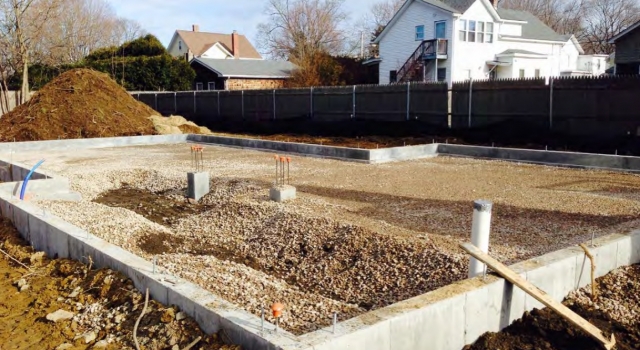

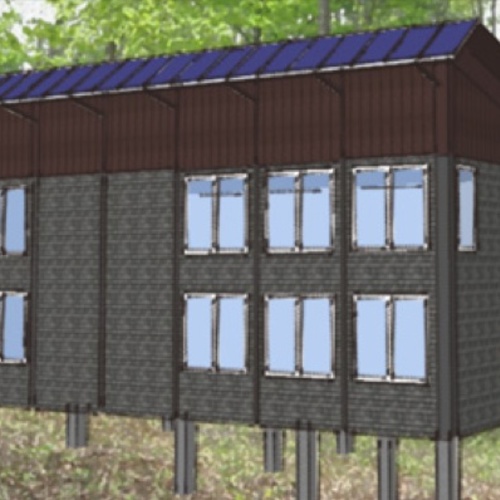
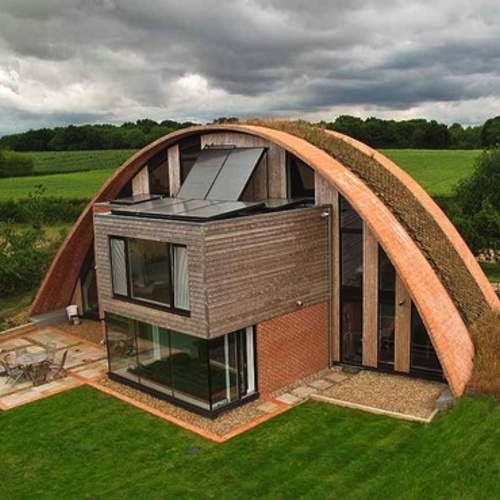
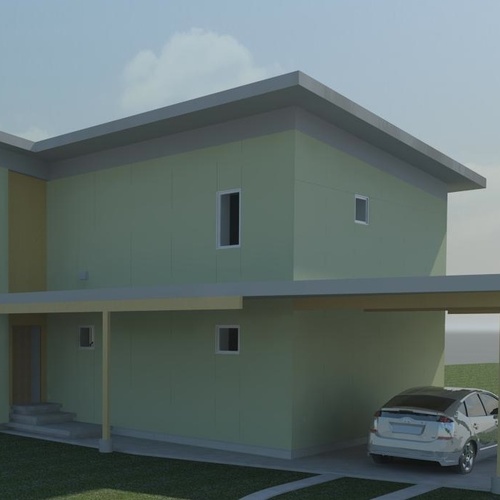






36 Comments
What an intelligent project
No exotic materials or techniques. Being comprehensible to both trades and future occupants means it should be easy to adapt or renovate.
A small point: I understand excluding the architect's and Passive House fees to see what the costs would be if the project were duplicated, but these really do form part of the budget and I'd be interested in what they were.
Response to Malcolm Taylor
Malcolm,
If you read the article again, you'll notice that I did provide an accounting of the Passive House fees. I wrote, "The costs associated with PHIUS certification were $8,000."
If I understand correctly, Steve Baczek donated his architectural services to this project -- or perhaps he just asked to be paid with a steak dinner at a nice restaurant (if I am correctly remembering Stephen DeMetrick's story).
Stephen -- if you're reading this, you can comment on the architect's fee.
GBA readers: If you plan to build an architect-designed house, don't think you can hire an architect for the price of a steak dinner. It's safer to budget several thousand dollars for that line item.
Thanks Martin
I was more interested in the Passive House fees (I missed seeing). if i pick a reasonable architecture fee from the typical range, the project still comes in at a very reasonable per sq foot cost of about $172. That's low!
Response to Malcolm Taylor
Malcolm,
So you just tacked on an additional $9 a square foot -- that's an extra $16,560 for the project.
So I'm assuming that you are figuring that the architect gets $16,560 -- or perhaps you are figuring that $8,000 goes to PHIUS for certification, and the architect gets $8,560.
Martin
The latter. Architectural fees for these types of projects are all over the place, so it seemed fair to use the same amount as the PH certification was costing.
Why foam required in walls?
"First we installed 4 inches of closed-cell Lapolla spray foam,” said DeMetrick, who didn’t sound totally comfortable with the idea. “PHIUS said we had to have the spray foam."
Is the requirement for closed-cell foam for keeping water vapor from condensing on the sheathing mid-winter, or ?
Response to Robert Opaluch
Robert,
My assumption is that the Passive House standard insisted on a high-R wall to meet the standard's (somewhat arbitrary) annual energy use target.
According to my calculations, the 4 inches of closed-cell spray foam (substituted for blown-in fiberglass) added about R-11.2 to the total R-value of the wall assembly (raising the R-value from about R-44.4 to about R-55.6).
In Climate Zone 5, a flash-and-batt wall (or a flash-and-fill wall) should be designed to have a minimum of 27% of the wall's total R-value in the form of closed-cell spray foam. This wall has about 46% of the total R-value of the wall in the form of closed-cell spray foam, so it passes the test.
Martin, Thanks for an
Martin,
Thanks for an accurate article on my presentation! A couple of comments to the comments:
1. The owners did compensate the architect for his services. I wasn't part of that transaction, so I don't know what the total design costs were. The comment about working for a steak dinner was only meant to provoke a laugh from the audience! And Steve and I enjoyed a few steaks together over the course of the project!
2. From my understanding, the amount of spray foam was required by PHIUS to manage the dew point in the wall as calculated by the WUFI modeling they were doing at the time.
Feel free to ask as many questions as you want, I would be more than happy to respond!
-Steve
Inexpensive Siding Alternatives
Our code is usually interpreted as precluding open siding. I've found that using Hardie Plank, or similar products, detailed and flashed as though they were metal siding, yields a cheap and easy to install cladding for budget-conscious jobs.
Late to this party but we're about to side a Zip Panel R30 mineral wool assembly. Planning on 1/4 batten for airgap and cedar tongue and groove but am very interested in the #2 pine rainscreen.
Question: tar paper over all the ZIP or just at penetrations?
Thanks in advance, Scott
Scott,
Every wall needs a water-resistive barrier (WRB) as well as flashing at penetrations.
Your first task is to define your WRB. If you are installing Zip sheathing, it would seem logical to use the Zip sheathing as your WRB -- and if you do, you'll need to tape the Zip sheathing seams. But if for some reason you don't want to use the Zip sheathing as the WRB, you could use asphalt felt ("tar paper") as your WRB instead.
Flashing penetrations is an entirely different matter, and a topic of its own. In general, asphalt felt is not a good flashing material. For more information on flashing, see "All About Flashing."
Martin,
We're all "zipped" up but the detail showing the tar paper flaps gave me pause.
Thanks for the links!
Scott,
Here's what I wrote: "DeMetrick continued, 'Zip sheathing is a WRB, but I don’t trust it. I like things to be lapped. You can’t do that with Zip.'"
In my article on WRBs ("All About Water-Resistive Barriers"), I wrote: "Builders who switch to Zip System wall sheathing will have to change some of their flashing details. Those who usually install conventional housewrap are accustomed to lapping the housewrap over window Z-flashing and other penetration flashings, so that gravity helps keep their walls dry. With Zip System wall sheathing, on the other hand, keeping the wall dry depends on chemistry — that is, on the adhesive component of Zip System tape and AC148 flashing tape.... Many builders ... use Zip System sheathing as part of their air barrier — while still using housewrap, since housewrap can be lapped over window flashings and may be more dependable than Zip System tape."
Spray Foam: Robert and Martin
I think another reason that the spray foam was needed is that PHIUS requires a WUFI analysis on double stud walls in which the exterior wall is the load-bearing wall (in climate zones 4 and up I think). Although we've learned from Martin, et al, that in practice, Double Stud Walls are probably just fine- I presume they still fail in WUFI simulations. PHIUS is more than performance- they want the building to be durable, etc.
PHIUS writes about this in their best practices guide that I cannot not seem to locate. I will post the link/pdf if I can track it down.
Response to Rick Evans
Rick,
I agree that from a moisture-management perspective, a flash-and-batt wall (or a flash-and-fill wall) is less prone to moisture accumulation in the winter, and therefore less risky.
The downside to this approach is that with a double-stud wall, you need a lot of spray foam -- especially in climates that are colder than Rhode Island. The spray foam is expensive, and some green builders try to avoid using spray foam.
PHIUS WUFI on double stud
Here is the link for the PHIUS Guidebook:http://www.phius.org/PHIUSplusdocs/PHIUS+CertificationGuidebook_v1.03.pdf
Its a nice read for anybody building a high performance home.
Regarding double stud walls in colder climates, PHIUS writes:
"Things to Avoid
Exterior load-bearing double-stud walls are discouraged in climate zones 3 and higher. These will generally incur additional certification cost for hygrothermal analysis (WUFI), need a spray foam global warming potential (GWP) impact calculation, or both. They tend to be too vapor- closed on the outside for those climates and also put the air barrier on the exterior where it will be less durable than a mid-wall air barrier.
In heating dominated climates, double stud walls should be of the interior load-bearing type, either Larsen truss (standoff truss) or the kind described in [9], [10]."
On a personal note- I love this home. Hats off to the architects and builders!
Martin- I agree
Hi Martin, I agree with you. I was just pointing out why PHIUS may have required the cc foam.
Double stud wall and moisture management
I have a limited understanding of water vapor management in walls, and have these questions...
Why wouldn't a smart vapor barrier, attached to the interior wall of a double stud wall, minimize wintertime condensation on the sheathing on the exterior wall of a double stud wall? The wall can dry to both the interior and exterior over the year. I believe I read GBA articles showing no moisture damage in double stud walls. Maybe this is the reason for the WUFI analysis, to verify the wall design poses no water-vapor-related threats?
My understanding is that in at least some parts of Canada, it is common practice to require an interior poly air and vapor barrier on walls, that would minimize moisture condensing on the sheathing in winter. Ply sheathing could dry to the exterior (just like it must with closed cell foam on the interior side). So wouldn't this work no differently for double stud walls as well as for a single stud wall?
Response to Robert Opaluch
Robert,
Scientists who measure the moisture content of wall sheathing on cold-climate walls insulated with fiberglass, mineral wool, or cellulose note that the moisture content of the sheathing rises in February and March. Generally the wall sheathing dries out in April and May.
An interior vapor retarder reduces this annual moisture spike, but does not eliminate it.
Walls with an adequately thick layer of exterior rigid foam, or an adequately thick layer of closed-cell spray foam on the interior side of the sheathing, do not exhibit the seasonal spike in moisture. The sheathing stays dry (especially when the wall has exterior foam sheathing).
Not too worried about heat loss through slab?
I am building something akin.
The vertical slab insulation (4 in EPS - R16) and subslab (6 inch EPS - R24-26) are not nearly as souped up as the attic insulation (R92). You could have had 10 inches of subslab or more. Was that an economic choice or did the building's upfront modeling say that you hit diminishing returns?
Polished cement finished floor is unfriendly for elders. We will cover ours with click-lock once the moisture is driven out of it.
That ERV looks beastly. How many of your 1800 sq ft was dedicated for the 'utility room'?
I worry about the 1x6s cupping over time, especially the way that the outside was sprayed but no mention of equivalent treatment on the underside. Also worried about rot from splashback and insect attacks on the bottom rows, that seem only 8 inches above final grade. I could not spot a drip edge at bottom, under the bottom siding board -- did you use metal flashing there? At least the 1x6 replacements will not need a special-order and individual boards are not interlinked so maintenance is easier.
I liked the use of small amounts of tar paper around penetrations as the top layer.
Tremco sealants are not cheap. Did you choose to use the "acoustical sealant" for exterior window area in favor of other the Tremco butyl sealant formulations because it is superior for the air blocking goals you had? I am debating using similar but have important low interior VOCs goal and not sure what these are like after 'curing' a while. Also, GBA generally likes Tremco acoustical sealant but I seem to recall occasional discordant opinions about its use in this way since manufacturer does not recommend and we do not know how it will age over the decades.
Did you have to set up active radon mitigation (ie, include a fan)?
I could not spot any of the 'control break' lines in the concrete across the kitchen/living area. How did you get them to blend in so nicely with the finished floor?
I was a little surprised that solar hot water panels were not part of the plans. Were the financial incentives not compelling enough? Here in MA, my expected break-even is much less than five years for three panels & 80 gallon exchange tank.
Thanks so much for sharing. We, too, are aiming for low per sqft cost so are minding the pennies.
Kenneth: ERV choice/ subslab
Kenneth, I was thinking the same thing about the choice of the Comfoair 350. That thing is a beast (both in terms of size, cost, and watts). If you call Zehnder and ask them to design a system for you - they will use the newer ASHRAE requirements. This will result in some big equipment like the CA350. You have to request a smaller machine.
This house probably only needs 60 CFM of ventilation to adhere to the BSC or previous ASHRAE standards. Yet the comfo-wir maxes out at 218 CFM. The builders could have saved more money by opting for smaller machine an or a different manufacturer .
Regarding Subslab insulation, PHIUS doesn't go overboard with this like PHI does in colder North American climates. Part of this may be the dimishing return you referenced as well as the global warming impact of more and more insulation.
You probably don't need too much insulation under slab compared to roof due to the delta T of each location. In the dead of winter, the soil under the slab of this house probably won't be below 45 degrees. The air above the ceiling might be -10 F.
Kenneth:
-the subslab
Kenneth:
-the subslab insulation was specified at 6" by our CPHC who, through the PHPP, dialed in all of our insulation levels to meet the PHIUS criteria and our budget goals. Yes, we could have put 10" under the slab like we were seeing in many certified projects before ours, but why spend the money and, more importantly the resources, if it isn't necessary?
- I agree that the polished concrete isn't the easiest under foot! In this case it fit the the aesthetic of the owners and also fit the budget, a rare alignment of cost and customer requests that more often than not adds to the budget! I would caution you about installing wood flooring over a concrete slab due to the slab moisture. If you really want the wood floor, you should check out an article in JLC I wrote about eliminating the concrete from a basement, we also did a "slab less" slab on grade house as well. I don't have a link, but it shouldn't be that hard to find.
- The utility room was about 4' x 8' and houses the zehnder and the heat pump water heater. There is additional volume in the room from the sloped area over the stairs. That and the louvered door allow the water heater to operate properly.
- the pine has been up for several years and isn't suffering from cupping. It was shop finished on all sides before installation and all cuts were field treated as we installed it. There is a full 3/4" air space behind the siding which allows for ample drainage and drying, and hence the lack of cupping. The perimeter of the house has an apron of crushed stone with perimeter drains and as a result has very little splash back, and again, because of the 3/4" airspace, the pine can handle the wetting and drying. Any metal drip edge or cap at the bottom would have added cost with zero benefit on this installation.
-The Tremco sealant cost about $16/29 oz tube. I've found it to be the most cost effective/overall effective air sealant in all the years I've been building like this. It can be installed at a wide spectrum of temperature (on this house we were using it in the coldest days of winter), and can be installed on wet surfaces without adverse affect. However, I don't like the VOC content. It is outside the spray foam, and the house is very well ventilated, so I'm not so concerned about the VOCs. I would still like to find a better option at that price point. I have high hopes for it's long term effectiveness on this project as a redundant seal since it is engineered to not cure.
- the house has a passive radon system that is ready to be active if needed.
- there are control breaks in the concrete, they just don't show up in the picture
- "solar hot water is dead" - ask Martin
Rick, The Zehnder we
Rick,
The Zehnder we installed is capable of running at that much CFM, but it is only set to run at around 120cfm, which works out to be about 3 ACH continuous for the house. When operated at this lower capacity, the wattage used is quite low compared to running it at full capacity. Also, the unit needs to be able to operate effectively in it higher CFM boost mode for cooking and ventilating bathrooms when showering, something the smaller unit wouldn't have done effectively. I don't totally geek out on these numbers, and in this case, I also do know the wattage was calculated as part of the totally energy use and operating costs for the project and it passed that sniff test. The total electric bill for the house averaged about $75/ month the first year. Again, without totally geeking out on the numbers, I would guess that the Zehnder was a small enough fraction of that, that the energy savings from a small unit wouldn't be enough to merit searching for an option more cost effective to operate. Lastly, I really trust this unit. The ventilation system is far and away the most important piece of equipment in this house and something that I will not compromise on. Over the years I have heard many more stories of projects that had problematic issues with ventilation systems installed to save on the cost of a Zehnder, and very few, if any, stories of people expressing buyers remorse from the extra $3000 (1% of the total building cost of this home) they spent on their Zehnder.
Steve
Response to Kenneth Gartner (Comment #16)
Kenneth,
Q. "I was a little surprised that solar hot water panels were not part of the plans. Were the financial incentives not compelling enough?"
A. It looks like Steve has answered all of your questions thoroughly, except for your question about solar hot water. Steve wrote, "Ask Martin."
Here are links to my two articles on the topic:
Solar Thermal is Dead
Solar Thermal Is Really, Really Dead
"This house probably only
"This house probably only needs 60 CFM of ventilation to adhere to the BSC or previous ASHRAE standards"
In many cases, the local building code supersedes any of these standards. I speak from experience on this. In our case, the code required even more than the newest ASHRAE standard (a lot more).
Of much more importance is that with a tightly sealed home and a dedicated ventilation system, the HRV is most likely doing double duty. You probably don't (or at least shouldn't) have a range hood or bathroom fans. With that in mind, sizing the HRV to max out at just above the continuous ventilation requirements would be very foolish. You need that capacity overhead to run when you're producing a lot of moisture and odours in the kitchen or bathrooms. The CA350 is probably a little more than what is necessary for 1840 square feet, but not by as much as you think. And the next size down, the CA200 would be too small.
Steve, did you mean 0.3ACH? I think that's the ballpark the PHI shoots for. The math doesn't work out right at 3ACH. Assuming a ceiling height of 8-9', your house volume is about 15,000 cubic feet. In order to get 3ACH, you would need 45,000 cf/h, or 750cfm. With the same assumed ceiling height, 120cfm works out pretty close to 0.5ACH.
Trevor,
I was missing a
Trevor,
I was missing a decimal point, thanks for pointing that out. I just looked up the design specs from our Zehnder quote. The volume is approximately 13,200 cubic feet, the designed CFM rate is 96 and the ACH number was .44. And no, this house did not have a range hood or any bath fans. These areas have continuous ventilation as well as a boost switch to up the ventilation rate when taking showers or cooking.
-Steve
Range hoods vs ventilation
Is full-time ventilation in a kitchen effective in reducing the harmful particulates that come from cooking? I know most people don't use their range hoods regularly anyway, I'm just curious.
Range hoods
I see some type of range hood in the photo -- presumably, Steven, it is a recirculating type rather than one equipped with an exhaust fan?
Cooking with gas is more hazardous (from an IAQ standpoint) than cooking with electricity, but many types of cooking (especially sauteeing, frying, and roasting) emit dangerous fumes, even when performed on an electric stove. There is increasing evidence that it's important to have (and use) a good exhaust fan mounted in a range hood.
Finally, many building codes require that homes have a range hood equipped with an exhaust fan.
Yes, a range hood is a must.
Yes, a range hood is a must. What I meant was you wouldn't have an externally ducted range hood. If there is evidence that a recirculating range hood is inadequate, that is something to consider at the design stage. In all the homes I've lived in, only one ever had an externally ducted range hood. I hated that thing because it just bled heat in the winter. There was a cold draft coming off it, and even the floor in front of the stove was ice cold when it was cold outside. I think it accounted for about 10% of the total heat loss in that house.
Trevor
That's what interests me - and I don't know enough about: Can you maintain adequately low levels of particulate in a kitchen without an externally vented range hood? Do either full-time ventilation or range hood filters provide an adequate substitute?
Martin,
There is a
Martin,
There is a recirculating range hood. The primary usage is for collecting some of the grease and odors. The zehnder is exhausting around 36 cfm continuously from the kitchen space (with a replaceable grease filter in the return grill) and the space is also under a slight depressurization when you look at the flow rates of the feeds and returns in the rest of the house. In regards to cooking in general, I flat out won’t let an owner install a gas cooktop or range in the homes I build. It’s that important. If I know they do so much cooking or a type of cooking that requires ventilation (I haven’t yet), I would have a properly sized hood with make up air installed.
-Steve
Response to Stephen DeMetrick
Stephen,
The approach you describe -- a recirculating range hood (with some kind of filter) along with an exhaust grille in the ceiling of the kitchen connected to the HRV -- is the standard Passivhaus solution.
That said, a lot of IAQ experts worry about the health effects of acrolein and particulates released by cooking. For more information of this issue, see All About Indoor Air Quality.
Foundations quandry
Hi all, Great article and thanks for products and costs!
We have a site that's a bit wet and are thinking to put the structure (passive-ish) on piers. It's nominally 18' x 48' plus the porch. I've attached a diagram showing where, when it rains a lot, a small amount of water flows, We're in the early planning stages, located mid-Hudson Valley near Germantown. Any thoughts on this approach?
My first post, Scott
Scott,
You need to redirect that water away from the piers, either by re-grading or installing a trench drain. If you particularly like having the water (some very nice houses have been built straddling creeks), you need to move your foundations out and have a longer free-span over the wet area.
Houses on piers benefit from having a small concrete core to accommodate the services (primarily sewer and water) which can be insulated. A deeper floor system can be very helpful making sure you can both run pipes and still maintain adequate insulation.
Good luck with your build.
Why #2 Pine boards with some Hardie... why not all Hardie? Was it an aesthetic, cost, or installation toxicity question?
Thank you Steve and Martin for this overview and focus on cost. Is there an itemized list of the costs of the main components that add up to the $300,420? Like the breakdown by framing lumber, HRV, heating, insulation, labor etc.? As someone who is embarking upon a build, to get a sense of the cost related to the decisions is very, very helpful.
Thanks Catherine T.
Log in or become a member to post a comment.
Sign up Log in